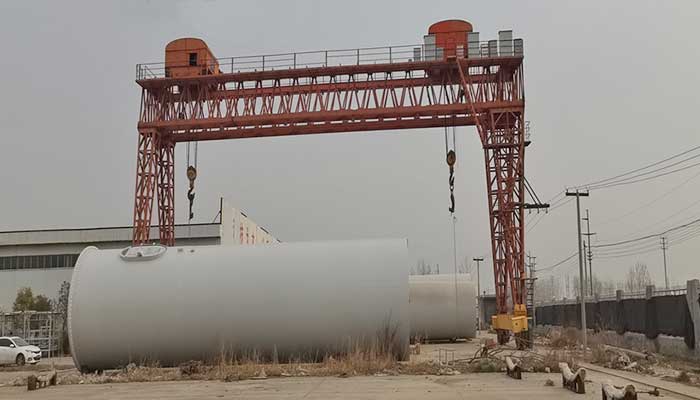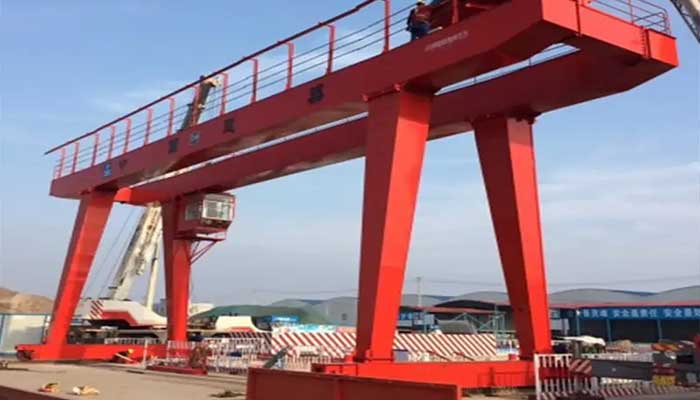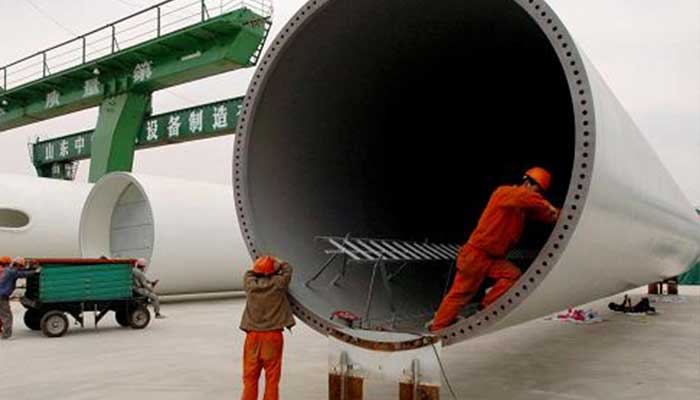
Gantry Cranes on Tracks Elevating Wind Turbine Construction
Your Trusted Gantry Crane Manufacturer & Supplier
Gantry Cranes on Tracks Elevating Wind Turbine Construction
50 tons to 150 tons gantry cranes on tracks for handling wind turbine components, blades & tower sections in wind energy farms & turbine assembly sites.
Gantry cranes on tracks have emerged as indispensable tools in the construction and maintenance of wind turbines, revolutionizing the efficiency and precision of lifting operations. These cranes, equipped with advanced tracking systems, provide a stable and versatile solution for handling heavy loads in the challenging environments of wind energy farms and turbine assembly sites.
The towering structures of wind turbines present unique challenges in construction, demanding specialized equipment that can navigate the complexities of assembling massive components at significant heights. Gantry cranes on tracks have proven to be the ideal solution, offering the necessary strength, stability, and adaptability required for wind turbine construction.
Efficient load handling is a critical aspect of wind turbine construction, where precision and safety are paramount. Gantry cranes on tracks play a pivotal role in this process, ensuring that components such as nacelles, generators, gearboxes, blades, and tower sections are lifted and positioned with the utmost accuracy. This not only enhances the safety of construction crews but also contributes to the overall reliability and longevity of the wind energy infrastructure.

double girder gantry crane for outdoor material handling
Typical Loads Handled
Wind Turbine Components
Nacelles
The nacelle, positioned at the top of a wind turbine tower, houses critical components that transform wind energy into electrical power. Gantry cranes designed for nacelle handling must have precise control and stability due to the intricate nature of these components. Nacelles often weigh several tons and contain sensitive equipment such as high-tech generators, gearboxes, and control systems. Gantry cranes on tracks are equipped with advanced lifting technologies to delicately place nacelles at the pinnacle of the turbine tower, ensuring the seamless integration of these vital components.
Generators
Generators are the powerhouses within the nacelle, converting the rotational energy of the turbine blades into electricity. Gantry cranes play a pivotal role in carefully positioning generators within the nacelle structure. The crane's tracking system allows for controlled movement, guaranteeing that generators are installed securely and precisely, optimizing the efficiency of the entire wind turbine system.
Gearboxes
Wind turbine gearboxes are intricate and heavy components that transmit the rotational energy from the blades to the generator. Gantry cranes on tracks, with their customizable tonnage capacities, provide the necessary strength to lift and install gearboxes with precision. Their ability to traverse the assembly area on predefined tracks ensures that gearboxes are seamlessly integrated into the turbine structure, contributing to the overall reliability and performance of the wind energy system.
Blades
Wind turbine blades are among the most challenging components to handle due to their sheer size, aerodynamic design, and susceptibility to damage. Gantry cranes designed for blade handling incorporate features such as specialized lifting attachments and precision control systems. The tracking system enables the crane to navigate the assembly area, carefully lifting and positioning the blades during installation. This meticulous handling ensures that the aerodynamic efficiency and structural integrity of the blades remain intact, optimizing the turbine's overall performance.
Tower Sections
The towering structure of a wind turbine is constructed using multiple tower sections, which are lifted and assembled to achieve the desired height. Gantry cranes with varying tonnage capacities are employed to handle the diverse sizes and weights of tower sections. These cranes move along predefined tracks, allowing for precise positioning of each section during the assembly process. The ability to handle heavy loads and navigate the challenging conditions of a construction site makes gantry cranes on tracks indispensable for the efficient and safe integration of tower sections, contributing to the structural stability of the wind turbine.
Typical Crane Application
Wind Energy Farms
On-site Assembly
In the vast expanse of wind energy farms, where multiple turbines are strategically positioned, on-site assembly is a critical phase in the construction process. Gantry cranes on tracks facilitate the on-site assembly by maneuvering through challenging terrains and reaching the designated turbine locations. These cranes are designed to handle various components such as nacelles, generators, gearboxes, blades, and tower sections with precision. The tracking system allows for controlled movement, ensuring that each component is lifted and placed accurately, contributing to the seamless construction of wind turbines on-site.
Maintenance and Repairs
Beyond the initial construction phase, gantry cranes on tracks continue to play a vital role in the maintenance and repair activities at wind energy farms. The flexibility in positioning provided by the tracking system allows these cranes to access turbines at different locations within the farm. Whether it's replacing a damaged blade, conducting routine maintenance on the nacelle, or addressing electrical components, gantry cranes on tracks expedite the process, minimizing downtime and optimizing the overall operational efficiency of the wind farm.
Turbine Assembly Sites
Installation of Components
Dedicated turbine assembly sites serve as centralized locations where individual wind turbine components are brought together for systematic assembly. Gantry cranes on tracks are instrumental in this phase, handling the installation of crucial components with precision. As nacelles, generators, and gearboxes are lifted into position, the tracking system ensures that the crane moves seamlessly along predefined paths, aligning each component accurately. This controlled process contributes to the efficient assembly of fully functional turbines at the designated site.
Integration of Tower Sections
The integration of tower sections is a meticulous process that requires careful planning and execution. Gantry cranes on tracks with varying tonnage capacities are employed to handle the diverse sizes and weights of tower sections. As each section is lifted and positioned, the tracking system guarantees precise alignment during integration. This methodical approach ensures the structural integrity of the wind turbine, making gantry cranes on tracks indispensable for the seamless integration of tower sections at turbine assembly sites.

L leg single girder gantry crane for wind power industry outdoor use
Typical Tonnages Used
Range: 50 tons to 150 tons
The versatility of gantry cranes on tracks lies in their ability to handle a wide range of tonnages, typically spanning from 50 tons to 150 tons. This expansive tonnage range allows these cranes to adapt to the diverse weight specifications of various wind turbine components, making them suitable for handling everything from intricate nacelles to massive tower sections.
Considerations for Nacelles, Generators, and Gearboxes
Nacelles, generators, and gearboxes are central components within a wind turbine, each with its unique weight and size characteristics. Gantry cranes must be carefully selected to match the tonnage requirements of these components. This ensures that the lifting operation is not only safe but also precise, preventing any potential damage during the installation process. The ability to adjust the tonnage capacity of the crane according to the specific requirements of nacelles, generators, and gearboxes enhances the overall efficiency of wind turbine construction.
Tonnage Requirements for Blades
Wind turbine blades, being among the largest and most aerodynamically sensitive components, demand specialized handling. Gantry cranes used for blade installation should possess tonnage capacities that align with the weight and dimensions of the blades. This tailored approach ensures that blades are lifted and positioned with the necessary stability, preventing any deformation or damage during the intricate installation process. Matching tonnage to the unique requirements of blades contributes to the overall success of wind turbine construction.
Tower Section Handling Capacities
Tower sections vary significantly in size and weight, requiring gantry cranes with adaptable tonnage capacities. The ability to handle tower sections efficiently is crucial for the seamless assembly of wind turbine structures. Gantry cranes on tracks, equipped with the appropriate tonnage capacities, ensure that tower sections are lifted and positioned accurately during integration. This careful handling not only contributes to the structural stability of the wind turbine but also enhances overall safety during construction.
The dynamic tonnage capabilities of gantry cranes on tracks underscore their versatility and suitability for the complex and varied demands of wind turbine construction. This adaptability ensures that the lifting operations are not only efficient but also tailored to the specific requirements of each wind turbine component.
Advantages of Gantry Cranes on Tracks
Gantry cranes on tracks have become the backbone of wind turbine construction, offering a range of advantages that contribute to the overall efficiency and safety of the assembly process.
Precision in Movement
One of the standout features of gantry cranes on tracks is their exceptional precision in movement. The tracking system allows for controlled and predictable motion along predefined paths. This precision is particularly crucial when dealing with delicate components such as nacelles, generators, and blades. The ability to move with accuracy ensures that each lift and placement operation is executed with meticulous care, preventing any misalignments or damage to the components. This precision is instrumental in achieving the high-quality standards required in wind turbine construction.
Flexibility in Positioning
Gantry cranes on tracks offer unparalleled flexibility in positioning, adapting to the dynamic requirements of wind turbine assembly. The ability to traverse along tracks allows the crane to access different areas of the construction site or wind energy farm with ease. This flexibility is vital during on-site assembly and maintenance, where the crane must navigate various terrains and reach specific turbine locations. The capability to position components accurately, even in challenging environments, enhances the overall efficiency of wind turbine construction and maintenance operations.
Safety Measures in Wind Turbine Construction
Safety is paramount in the construction and maintenance of wind turbines, given the height and complexity of these structures. Gantry cranes on tracks incorporate advanced safety features to mitigate risks during lifting operations. The tracking system ensures stable movement, reducing the likelihood of accidents or collisions. Additionally, the precision control allows for gradual and controlled lifts, minimizing the potential for damage to both the components and the crane itself. These safety measures contribute to a secure working environment, protecting the construction crew and preventing costly accidents.
Time and Cost Efficiency
The efficiency of gantry cranes on tracks extends beyond precision and safety, directly impacting the overall timeline and cost of wind turbine construction. The controlled and precise movements reduce the time required for each lifting operation, accelerating the assembly process. The flexibility in positioning also streamlines maintenance and repairs, minimizing downtime. Furthermore, the adaptability to different tonnages ensures that the crane can handle various components without the need for frequent changes. This time and cost efficiency make gantry cranes on tracks a cost-effective and productive solution for the wind energy industry.
In summary, the advantages of gantry cranes on tracks, including precision in movement, flexibility in positioning, safety measures, and time and cost efficiency, position them as indispensable tools in the construction and maintenance of wind turbines. Their contribution to the success of wind energy projects is evident in their ability to navigate the complexities of these operations with unparalleled efficiency and reliability.
Features and Capabilities
WindLift distinguishes itself through a myriad of cutting-edge features and capabilities that elevate its performance in wind turbine construction:
- Advanced Tracking System: WindLift integrates a state-of-the-art tracking system, allowing for precise and controlled movements along predefined paths. This feature ensures accurate positioning of components during the assembly process.
- Customizable Tonnage Capacities: WindLift offers a range of tonnage capacities, from 50 tons to 150 tons, providing flexibility in handling various wind turbine components. The ability to customize tonnage ensures that the crane is optimally matched to the specific weight requirements of different elements.
- Safety Enhancement Mechanisms: WindLift incorporates advanced safety measures, including collision avoidance systems and stability controls. These features enhance the overall safety of lifting operations, mitigating risks associated with the assembly of wind turbines.
- Adaptable for Varied Terrains: Designed to navigate challenging terrains commonly found in wind energy farms, WindLift's adaptability ensures that it can efficiently traverse different surfaces, from soft soils to uneven landscapes.
Success Stories in Wind Turbine Construction
WindLift has garnered acclaim through its successful contributions to wind turbine construction projects globally. Some notable success stories include:
- Timely Completion of Large-Scale Wind Farms: WindLift has played a pivotal role in expediting the construction of large-scale wind farms, ensuring timely completion and successful commissioning. The efficiency in handling components has led to enhanced project timelines.
- Precision in Blade Installation: WindLift's precision in movement and adaptable tonnage capacities have resulted in the flawless installation of wind turbine blades, minimizing the risk of damage and contributing to the overall performance of the turbines.
- Enhanced Safety Records: Projects employing WindLift have reported improved safety records, with reduced incidents and accidents during lifting operations. The incorporation of safety features has contributed to creating a secure working environment.
Future Prospects and Innovations
As technology evolves, WindLift remains committed to continuous improvement and innovation within the wind energy construction sector:
- Integration of AI and Automation: WindLift is exploring the integration of artificial intelligence and automation to further enhance crane operations. This includes real-time monitoring, predictive maintenance, and automated path planning for increased efficiency.
- Environmental Sustainability: Future iterations of WindLift aim to incorporate sustainable design principles, with a focus on energy efficiency and reduced environmental impact. This aligns with the growing emphasis on sustainable practices within the renewable energy sector.
- Global Collaboration and Standardization: WindLift envisions collaborative efforts with industry stakeholders to establish standardized practices for gantry cranes on tracks in wind turbine construction. This initiative aims to streamline processes, improve interoperability, and foster a more cohesive approach to industry challenges.
In conclusion, WindLift exemplifies the pinnacle of gantry crane technology, elevating the efficiency, safety, and success of wind turbine construction. Its features, success stories, and future prospects underscore its crucial role in shaping the future of renewable energy infrastructure.
Conclusion
Throughout the discourse on gantry cranes on tracks in wind turbine construction, it is imperative to underscore their paramount importance. These cranes have become indispensable tools, addressing the intricate challenges posed by the assembly and maintenance of wind turbines. The ability to handle diverse components, ranging from nacelles to tower sections, with precision and safety has elevated gantry cranes on tracks to a central role in the success of wind energy projects.
Among the myriad of gantry cranes, WindLift emerges as a beacon of excellence in the field. Its advanced tracking system, customizable tonnage capacities, and commitment to safety have set a new standard for efficiency in wind turbine construction. WindLift's success stories in expediting project timelines, ensuring precision in component placement, and improving overall safety records highlight its pivotal contribution to the success of wind energy initiatives globally.
The evolution of gantry cranes on tracks, exemplified by WindLift, signifies a broader trend in the continuous advancement of wind turbine construction technology. As the demand for renewable energy surges, innovations in crane technology become integral to ensuring the scalability and sustainability of wind energy projects. The integration of AI, automation, and sustainability considerations, as envisioned in WindLift's future prospects, reflects the industry's commitment to embracing cutting-edge solutions.
In conclusion, the marriage of gantry cranes on tracks and wind turbine construction technology not only symbolizes the present state of efficiency and safety but also paves the way for a future where renewable energy infrastructure can be constructed with even greater precision, speed, and environmental consciousness. The journey of WindLift represents a paradigm shift, shaping the narrative of wind energy construction towards a more advanced, sustainable, and technologically sophisticated future.